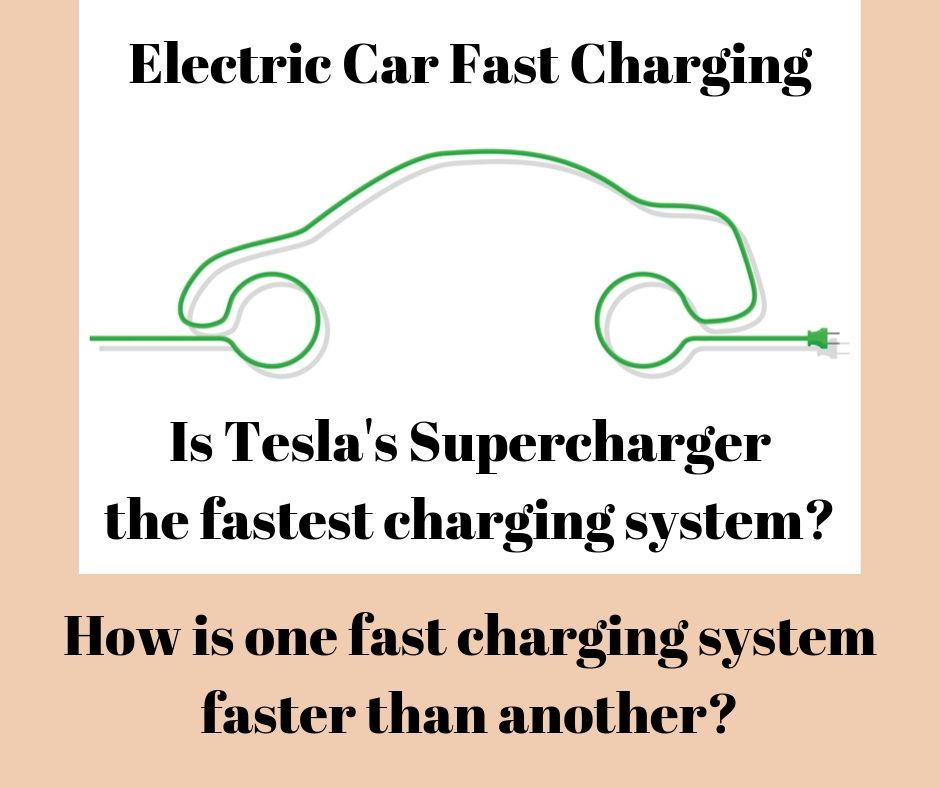Last Update: October 12, 2019

The Tesla Supercharger network is generally faster than other fast charging systems. The situation is rapidly changing since the other automakers are implementing higher speed fast charging as well. To understand this and what it means, we need to briefly discuss the technology of recharging electric cars.
Measuring EV charging speed
The charging rate for electric cars is measured in kiloWatts. The kiloWatt is a standard unit of the quantity of electricity. For example a typical hair dryer consumes a bit less than 1 kiloWatt of electricity. To charge an electric car more quickly requires increasing the charging rate - e.g. shifting from a 25 kiloWatts to 50 kiloWatts charging rate halves the charging time, roughly speaking.
For some detail on this see:
- Electric car charging speed and effective trip speed on road trips
- Charging levels - Level 1, Level 2, DC Fast Charging, etc
- What electric car charging rate do we need at home, at the office, on road trips, at airports, or elsewhere?
Almost every fast charging systems use DC electricity. With traditional AC charging, on-board equipment converts the AC to the DC current required to charge the pack. With DC charging, the on-board AC equipment is bypassed and the AC to DC conversion is done using high-power electronics in the charging station.
For some detail on this see:
- EV DC Fast Charging standards – CHAdeMO, CCS, SAE Combo, Tesla Supercharger, etc
- EV AC Fast Charging Systems – Renault ZOE, Smart ED
Why is fast charging faster?
A fast charging system pumps more kiloWatts into the battery pack than slow charging.
It seems from the way folks discuss the Tesla Supercharger it's some kind of magic holy grail of special technology. No. It simply pumps more kiloWatts than the competing system. But we're getting ahead of ourself and we have to first understand why this makes a difference.
Battery pack capacity is measured in kiloWatt-hours. This unit measures a quantity of electricity. Where the kiloWatt measures the power level at an instance, the kiloWatt-hour adds up a total amount of electricity over a period of time. One kiloWatt-hour is, as the name implies, 1 kiloWatt for 1 hour.
Roughly speaking (oversimplifying) the charging time is calculated by dividing the kiloWatt-hours required by the charging rate. Therefore, roughly speaking, recharging 100 kiloWatt-hours at a 50 kiloWatt rate takes two hours, at a 100 kiloWatt rate requires 1 hour, and at a 200 kiloWatt rate takes 1/2 hour.
Among the details skipped over is that as a battery pack nears full the charging rate tapers off. The actual charging time is longer than those simplistic calculations, but the concept is sound. Charging time is a factor of the kiloWatt-hours to recharge and the charging rate in kiloWatts.
There's a lot of engineering work going into increasing the charging rate, and thereby decrease the charging time. One tactic is to use liquid cooling in the charging cable to reduce heat build-up. Another is to develop batteries capable of receiving electricity at a faster rate. For more, see:

What's the fastest charging system of them all?
With that background material under our belt, we can understand these pieces of data:
- DC Fast charging was introduced with the CHAdeMO standard in 2008
- Until 2017-2018 the non-Tesla fast charging overwhelmingly ran at 50 kiloWatts maximum
- Starting at about that time the non-Tesla electric car makers began supporting higher charging rates, and the charging networks have slowly introduced higher speed DC fast charging stations at rates up to 350 kiloWatts
- When introduced in 2013 the Tesla Supercharger network supported 90 kiloWatt fast charging, then moved to 120 kiloWatt
- Beginning in March 2019 Tesla began upgrading the V2 Supercharger network to a 145 kiloWatt charging rate
- At the same time Tesla announced the V3 Supercharger system which supports 250 kiloWatt charging
As a practical matter the vast majority of non-Tesla DC fast charging installed in the wild supports 50 kiloWatts charging. We should expect that to change, but there is a lot of installed systems that will likely stay right where they are. As inter-city non-Tesla starts to be installed, those systems are likely to support higher charging rates.
But, all along the Tesla Supercharger network ran at about twice the 50 kW charging rate. Tesla's latest move is an upgrade to about 5x that charging rate. That means Tesla is maintaining its lead in fast charging, except for the 350 kiloWatt rate supported by a few stations in Europe using the Combo Charging System charging protocol.
So, yes, it is true that the Supercharger network is generally the fastest charging experience. Conditions are rapidly changing, however.


